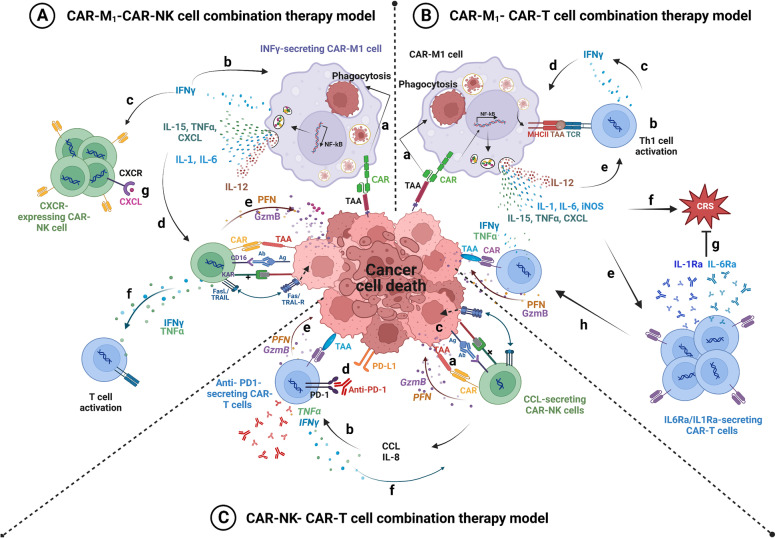Fig. 5.
Combined CAR cells therapies would improve their efficacy. A CAR-M1/CAR-NK cell combination therapy model. (a) CAR-M1 genetically modified to secrete INF-γ recognize the TAA through the CAR and phagocyte the tumor. (b) The continuous secretion of INF-γ by these CAR-M maintains them in M1 phenotype and (c) induces the recruitment of CAR-NK cells genetically modified to express CXCR. Additionally, CAR-M1 secrete IL-1, IL-12 and IL-15 which (d) induce the upregulation of CAR-NK KAR), CXCR, FASL and CD16. The upregulation of activated CAR-NK cells (e) enhanced cytotoxicity against tumor cells. Additionally, activated CAR-NK cells secrete IFN-γ and TNFα which (f) stimulate endogenous cytotoxic T cells. Moreover, (g) CXCR-expressing CAR-NK cells have a higher potential to migrate and infiltrate the CXCL secreting TME. B CAR-M1/CAR-T cell combination therapy model. (a) CAR-M1 recognize TAA with CAR and phagocyte the tumor. TAA presentation by CAR-M1 induces (b) the activation of Th1 immune responses. The interaction between CAR-M1-MHC-TAA and Th1 induces (c) IFN-γ production by Th1. (d) IFN-γ maintains CAR-M in M1 phenotype. (e) Activated CAR-M1 cells produces pro-inflammatory cytokines and chemokines, ROS and TNF-α involved in the activation of Th1 and the recruitment of CAR-T cells into the tumor site. (f) CAR-M1 are also able to produce NO which contributes with IL-1 and IL-6 to the generation of CRS. (g) IL-1Ra-expressing-genetically modified CAR-T cells inhibit the CRC mediated by IL-1 and IL-6. (h) Recruited CAR-T cells recognize TAA and induce tumor cytotoxicity. C CAR-NK/CAR-T cell combination therapy model. (a) CAR-NK cells recognize TAA by CAR and ligands expressed on tumor cells. (b) CCL-secreting CAR-NK cells recruit CAR-T cells by releasing IL-8, CCL3, and CCL5. CAR-NK expressing chemokines are better recruited to cancer cells and (c) kill them directly by apoptosis. (d) CAR-T cells secrete PD-1 blocking antibodies and inhibits this interaction with PDL-1. (e) CAR-T cells induce cancer cells killing by releasing granzyme and perforin. (f) CAR-T cell recruit CAR-NK

